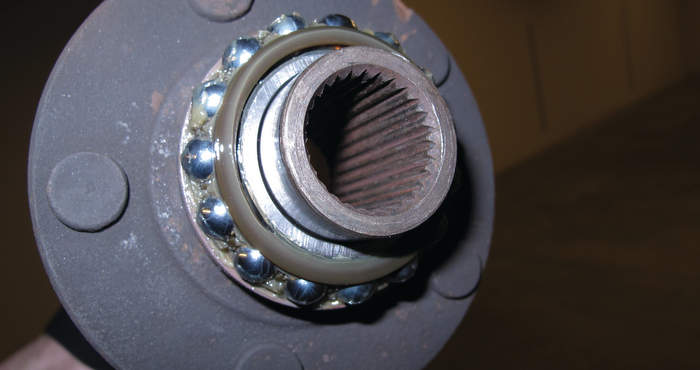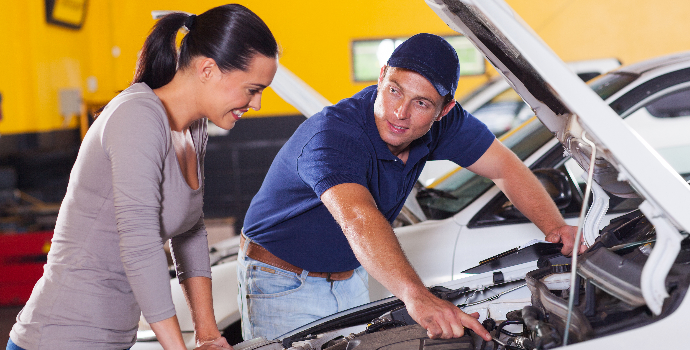Brake Edge Code Updates Explained
Notice anything different about those edge codes on that set of brake pads you just ordered? If you haven’t yet, you will. Here’s the deal: Brake friction formulations are now covered by new regulations in California and Washington, which require the phase out of copper and other metals potentially harmful to the environment. As a
Cartridge-Style Wheel Bearing Inspection, Installation Nuances
More and more vehicles are being equipped with cartridge-style wheel bearings — a style that requires a lot more labor to replace when compared to hub units or tapered roller bearings. What’s new? What should you watch for? While the fundamentals of the job have not changed since the 1980s, what has changed is the

Late-Model Brake Job Tips For Pontiac, Chevy, Cadillac, GMC And Buick
GM currently has about eight active vehicle platforms in North America, and many of these platforms share foundation brake technology and systems, like ABS and parking brakes. Compared to the previous generation of GM vehicles, these brake systems are more robust, yet more precise, and focused on reducing brake noise problems. Nearly every GM passenger
Eight Keys To Selling Auto Service
You’ll need to know your customers’ buying habits as well as their service histories. You should always request your first-time customers’ service records, and should ask them about their service histories verbally as well. This information can be extremely helpful during any sales process, especially when it comes to selling maintenance.

Why Chasing The Cheapest Brake Job Costs Your Shop In The Long Run
Ever since the 1930s, there has been a war on the price of brake jobs. Eighty years ago, shops were advertising low-priced brake relines on sandwich boards for $19.99, but they complained about “gyps” selling brake jobs for $9.99 on the side of the road. We see almost the same situation today. This time the price point is around $150. Instead of gyps, shops are complaining about some guy on Craigslist who will perform a brake job for around $40 if he is provided with the pads.
Measuring Ball Joint Wear
Detecting and measuring wear in a ball joint is critical to ensuring the safety of a vehicle. When a ball joint fails, the driver loses control of the vehicle. This can result in damage not only to the suspension, but also the axle shafts, brakes and even the body.
10 Reasons Why You Don’t Sell More Loaded Shocks And Struts
Do you only look at the shocks and struts when the driver complains of a noise or when the vehicle can’t be aligned? This might be just one of several reasons you aren’t selling more loaded shocks and struts despite a vehicle’s need for them. Here are 10 tips to help you better identify the need for shocks and struts and for effectively educating your customers to make the sale.
Start Solving Transmission Electronic Control Problems
Troubleshooting an automatic transmission can be one of the most intimidating diagnostic procedures at a shop. The first reaction is typically, “We don’t do that type of work.” But there is profit in performing drivetrain diagnostics and “in-the-car” repairs.
Aluminum Suspension Component Serviceability
For every 10 percent reduction in vehicle weight, there is a 5 to 7 percent fuel savings. Since 1990, there has been a steady increase in the weight of vehicles due to airbags, structural components and convenience features like heated seats. This fattening in some areas forced suspension components to go on a diet.
New Environmental Regulations To Change The Parts You Sell, Install
New legislation is changing what parts can be installed on your customers’ vehicles. The goal of these mandates is to reduce emissions and prevent harmful chemicals from reaching waterways. The spirit of the new regulations is to preserve public assets like parks and streams that improve the quality of life for the citizens of the state.
How Does The EGR And Secondary Air Injection Work With The Catalytic Converter?
The perfect internal combustion vehicle would be able to put the exact amount of fuel and air into the combustion chamber. If the perfect combustion event happened, you would get nothing more than water and carbon dioxide. There would not be any unburned fuel or oxygen. What would be needed to make this happen? Direct injection into the combustion chamber is a good start. You would also need the perfect combustion chamber free from hot spots – areas of unwanted turbulence or carbon build up. In the mean time, we have exhaust gas recirculation systems (EGR), secondary air injection and catalytic converters to reduce emissions
